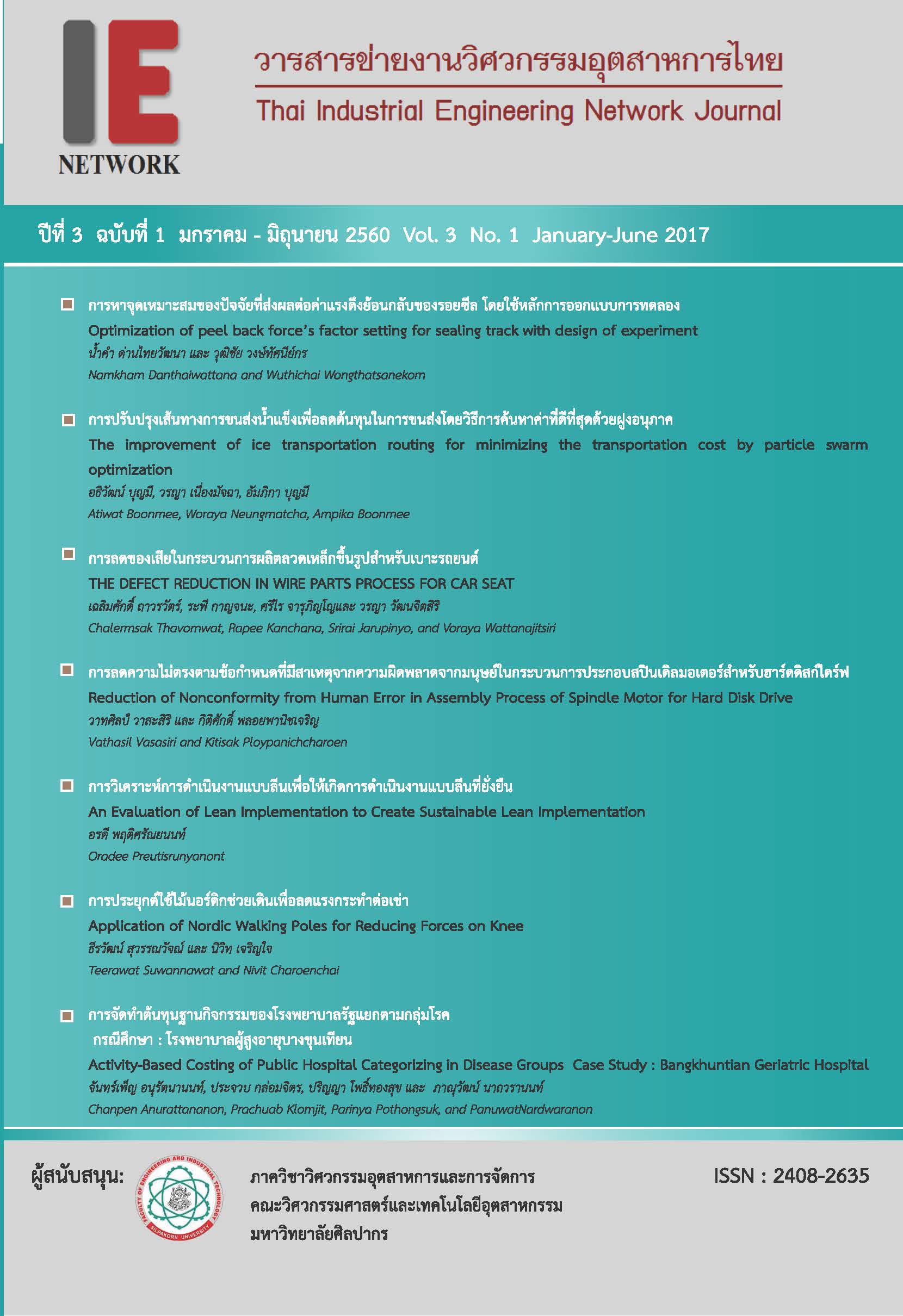Optimization of peel back force’s factor setting for sealing track with design of experiment
Main Article Content
Abstract
This article aims to find optimal setting of peel back force from seal track in integrated circuit industry by using the principles of design of experiment. Due to current process capability (Cpk) of peel back force was still out of specification and it had not passed requirements of the company. The analysis of parameters was performed using cause and effect matrix and failure mode and effects analysis. It was hypothesized that seven factors would influence to peel back force. Therefore, the experiments consisted of two steps. The first step of the experiment was screening to find the significant factors with fractional factorial design (27-1). The second step was to use significant factors to determine appropriate operating setting by performing (24) full factorials design. And optimization of peel back force’s factor setting for sealing track from four methods then select the method that most likely target. Work procedures were adjusted according to new appropriate parameter settings of each factor to establish new working standard along with setting training program. The result found that the Cpk increased to 1.98 which was higher than company target at 1.67.
Article Details
บทความ ข้อมูล เนื้อหา รูปภาพ ฯลฯ ที่ได้รับการตีพิมพ์ในวารสารฯ ถือเป็นลิขสิทธิ์ของวารสารฯ หากบุคคลหรือหน่วยงานใดต้องการนำทั้งหมดหรือส่วนหนึ่งส่วนใดไปเผยแพร่ต่อหรือเพื่อกระทำการใดๆ จะได้รับอนุญาต แต่ห้ามนำไปใช้เพื่่อประโยชน์ทางธุรกิจ และห้ามดัดแปลง
References
[2] วราวุฒิ แก้วอ่อน, การลดของเสียจากขั้วเสาเปลี่ยนสีของแบตเตอรี่รถจักรยานยนต์, สาขาวิศวกรรมอุตสาหการ, คณะวิศวกรรมศาสตร์,จุฬาลงกรณ์มหาวิทยาลัย, 2556
[3] สมภพ ตลับแก้ว, การประยุกต์ใช้วิธีการ FMEA เพื่อการปรับปรุงความพึงพอใจของลูกค้า,วารสารพัฒนาเทคนิคศึกษา, ปีที่ 21 ฉบับที่ 68,2551
[4] เยาวนาฎ ศรีวิชัย, การลดผลิตภัณฑ์มีตำหนิในการผลิตลวดตาข่ายโดยใช้เทคนิคซิกซ์ ซิกม่า, สาขาวิศวกรรมอุตสาหการ, คณะวิศวกรรมศาสตร์, มหาวิทยาลัยเชียงใหม่, 2554
[5] กานดา พูนลาภทวี, สถิติเพื่อการวิจัย, สำนักพิมพ์ฟิสิกส์เซนเตอร์, ภาควิชาครุศาสตร์เทคโนโลยี,คณะครุศาสตร์อุตสาหกรรมและวิทยาศาสตร์,
สถาบันเทคโนโลยีพระจอมเกล้าพระนครเหนือ,2539
[6] ปารเมศ ชุติมา, การออกแบบการทดลองทางวิศวกรรม, กรุงเทพฯ: สำนักพิมพ์แห่งจุฬาลงกรณ์มหาวิทยาลัย, พิมพ์ครัง้ ที่ 1, 2545
[7] โสภิดา ท้วมมี, การลดปริมาณของเสียในกระบวนการผลิตพลาสติกแผ่น โดยใช้วิธีการประยุกต์การออกแบบการทดลอง กรณีศึกษาบริษัทในอุตสาหกรรมการผลิตพลาสติก, คณะวิศวกรรมศาสตร์, สาขาวิศวกรรมอุตสาหการ,มหาวิทยาลัยเทคโนโลยีพระจอมเกล้าพระนครเหนือ, 2550


